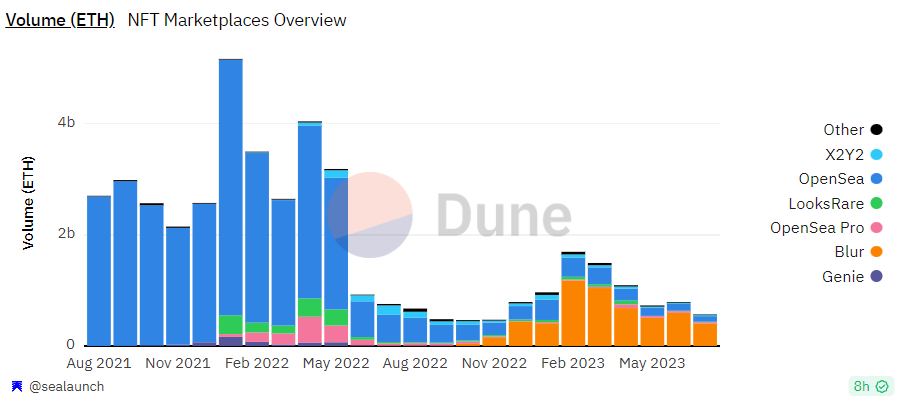The segments of non-fungible tokens (NFTs) and play-to-earn applications (P2E) suffered the most in the latest bearish recession. Data analysts tracked the crucial metrics of the Ethereum (ETH) NFT sphere to discover the scale of the collapse it faced.
From $5.1 billion to $568 million: Ethereum NFT segment registers its worst month since FTX collapse
July 2023 was the worst month for Ethereum (ETH) NFTs since last November; aggregated trading volume on major marketplaces dropped to $568.5 million in equivalent per month. As such, the segment witnesses an almost 90% decrease of trading volume compared to the whopping results of January 2022.

Such calculations were published by Sealaunch, a team of NFT data researchers, through a custom-made dashboard on Dune Analytics platform.
Meanwhile, the number of unique NFT users dropped to 107,000 holders; this is a multiyear low. In the last 12 months only, it dropped by over 66%.
Also, the count of independent addresses for OpenSea monthly transactions has dropped to 64,600, which is also below two-year lows. Last but not least, the aggregated number of NFT sales lost 82% from the peak registered in February 2022.
To provide context, the largest metaverse-associated projects lost over 95% of their tokens’ capitalization volumes, as covered in U.Today’s guide.
Rise and further rise of Blur (BLUR) marketplace
At the same time, for some new actors this recession resulted in achieving market dominance. Novel project Blur (BLUR), which stole all the headlines with its airdrop, replaced old leader OpenSea in a number of indicators.
For instance, in July 2023, its trading volume eclipsed that of OpenSea by 300%. In Q1, 2023, Blur (BLUR) even managed to surpass OpenSea by the number of NFT sales.
Blur (BLUR) scored all of these accomplishments, delivering its services to a 3x smaller userbase compared to OpenSea, the researchers noted.

